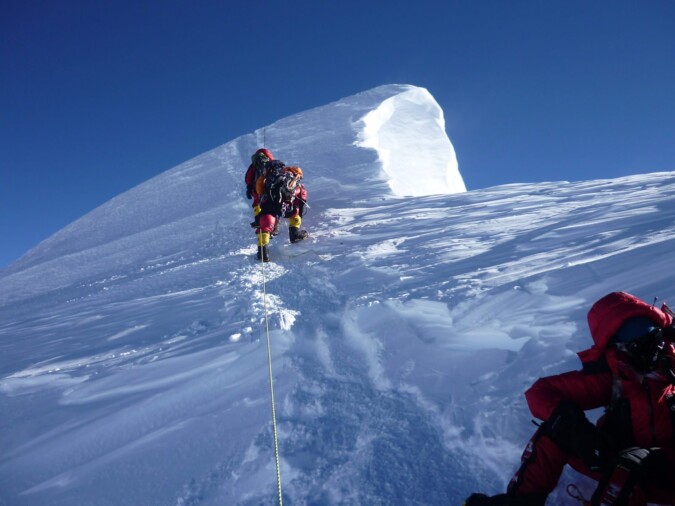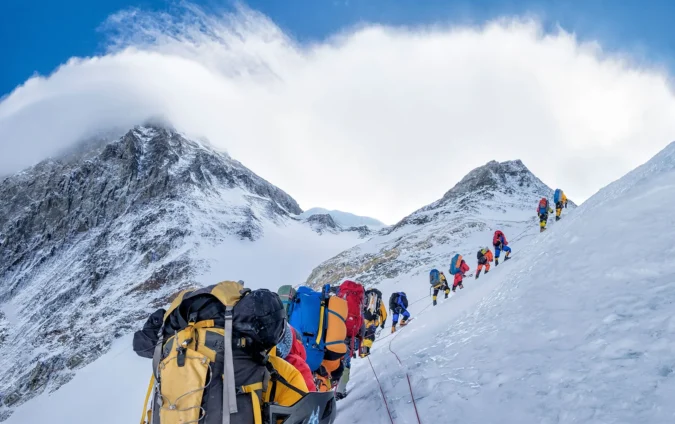For those who dream of reaching Everest’s towering summit, planning the climb is far more than just about picking the right gear or getting in shape.
Timing is everything, and Everest demands that you align with its harsh and unpredictable nature.
So if you’re looking at the best time to go for your Everest adventure, let’s walk through what each month brings to the world’s tallest peak.
Why Timing Matters for an Everest Climb
Everest is more than just a mountain—it’s an ecosystem, a realm where every tiny detail can mean the difference between reaching the summit or not.
When planning an Everest expedition with SummitClimb, timing is crucial due to the mountain’s extreme weather and fluctuating conditions throughout the year.
From fierce winds to extreme cold, each season brings unique challenges, and knowing what to expect can help you make better choices about when to start your climb.
Breaking Down the Climbing Seasons
There are two main climbing seasons on Everest:
- Spring (April to early June) ─ The most popular climbing window, spring offers generally favorable weather, thanks to a slight warming trend and fewer unpredictable weather events.
- Fall (late September to November) ─ Less popular and colder, but it’s a quieter season with fewer climbers.
Let’s explore Everest month by month to see what each period offers—or throws at you!
The deep winter months of January and February are for only the most daring and experienced climbers. Temperatures dip to jaw-dropping lows, regularly reaching -60°C (-76°F) near the summit, with heavy snow and powerful winds. Very few expeditions attempt Everest during this time.
Reasons to Avoid January and February
- Extreme cold, even at Base Camp.
- High risk of frostbite.
- Winds can exceed 160 km/h (100 mph), making it nearly impossible to climb safely.
- Minimal sunlight means short days and frigid nights.
If you’re hoping for more than just a physical and mental challenge—maybe a bit of scenery and a fighting chance against frostbite—winter probably isn’t your ideal season.
March
March marks the beginning of spring, and it’s when Everest Base Camp begins to fill with climbers, guides, and porters. The weather begins to stabilize, and temperatures are slightly more tolerable, though conditions remain tough.
March at a Glance
- Base camp temperatures ─ Around -15°C to -20°C (5°F to -4°F).
- Summit temperatures ─ Still extremely cold, but less so than the depths of winter.
- Winds ─ Begin to calm down somewhat, though high-altitude gusts are still a factor.
Pros of Climbing in March
- Smaller crowds compared to peak spring months.
- Fewer logistical delays since most teams are just arriving and setting up.

April
April is when Everest really comes alive with climbers. Weather conditions stabilize further, making it one of the most popular months to start the ascent.
Temperatures are relatively mild (for Everest, at least!), and the infamous jet stream starts to shift away from the mountain, calming those fierce winds.
April Highlights
- Base camp temperatures ─ -5°C to -10°C (23°F to 14°F).
- Summit temperatures ─ -25°C to -30°C (-13°F to -22°F).
- Crowds ─ High, with many teams on the mountain.
Why April Works Well
- More predictable weather patterns, make it easier to schedule summit attempts.
- Moderate winds make the climb more manageable.
- Generally clear skies for those epic views.
April is an ideal time to begin the journey if you want a greater chance of success and can handle the crowds.
May Is the Prime Climbing Month
May is often considered the “golden month” for climbing Everest. Conditions are usually at their most favorable, and the weather window for summit attempts is most reliable.
The jet stream continues to shift away, and many teams prepare for their summit push during the last two weeks of the month.
May Breakdown
- Base camp temperatures ─ -5°C (23°F) or warmer.
- Summit temperatures ─ -20°C to -25°C (-4°F to -13°F).
- Wind speeds ─ Lower than previous months, creating a safe period to attempt the summit.
Key Reasons to Pick May
- Reliable summit windows.
- Weather is as “mild” as Everest gets.
- Base Camp has a vibrant atmosphere with teams from around the world.
However, May’s popularity brings crowds, especially near the summit, which can lead to bottlenecks in dangerous sections.
Yet, if you’re determined to stand on the roof of the world, May is the time when most climbers are successful.

June
June marks the end of the spring climbing season. The monsoon winds begin to sweep in, and the conditions on the mountain change drastically. Heavy snow and rain make conditions dangerous and unpredictable.
What June Looks Like
- Base camp temperatures ─ Mild but wet.
- Summit temperatures ─ -20°C to -25°C (-4°F to -13°F).
- Conditions ─ Unpredictable, with frequent storms and snowfall.
Why avoid June? Once the monsoon sets in, visibility drops, and snow accumulation makes the climb more treacherous. Most teams aim to finish their expeditions by early June.
July and August
The monsoon fully takes over in July and August, bringing heavy precipitation, frequent avalanches, and dangerous climbing conditions. The mountain is largely deserted during these months.
Why July and August Are No-Go Months
- Frequent avalanches due to snow buildup.
- Extremely slippery conditions on the icefall.
- High risk of rockfalls and landslides from rain and melting snow.
Few climbers even consider Everest during this season, as the risk is just too high.
September
September marks the end of the monsoon season, but conditions remain highly unpredictable.
Many climbers avoid September because the mountain is still wet, and recent rains can make trails muddy and slippery.
September Snapshot
- Base camp temperatures ─ Cool and damp.
- Summit temperatures ─ -15°C to -20°C (5°F to -4°F).
- Conditions ─ Unstable with lingering rain and occasional snow.
If you’re set on a fall climb, waiting until October is usually the safer bet.

October
October is the best month for those who prefer fewer crowds and can handle a bit more chill. The skies clear up, and the snow starts to harden, making it easier to navigate trails.
October Highlights
- Base camp temperatures ─ Around -10°C (14°F).
- Summit temperatures ─ Around -20°C to -25°C (-4°F to -13°F).
- Conditions ─ Clear skies, but cold and windy at higher altitudes.
Why Choose October
October offers a quieter experience, but you’ll need to be ready for colder conditions and stronger winds.
November
November is when the fall season starts to wind down. Temperatures continue to drop, and conditions become less forgiving. Only a handful of climbers attempt Everest in November.
November Overview
- Base camp temperatures ─ -15°C to -20°C (5°F to -4°F).
- Summit temperatures ─ Drop to around -30°C (-22°F).
- Conditions ─ Harsh winds, colder temperatures, and limited daylight.
Most climbers find November too challenging due to the severe drop in temperature, and few teams remain on the mountain.
December
By December, Everest is once again locked in its winter embrace. Bitter cold, fierce winds, and heavy snow make climbing nearly impossible.
Those who head up in December are usually seasoned winter mountaineers or researchers.
December Drawbacks
- -60°C (-76°F) temperatures on the summit.
- Frequent storms and whiteouts.
- Unpredictable winds.
For all but the most extreme adventurers, December through February is best avoided.
Final Thoughts
Picking the right month for your Everest climb depends on your goals, experience, and tolerance for crowds or extreme cold.
If you’re a first-timer or seeking the most favorable weather, spring, especially May, is your best bet. For those craving solitude and willing to endure colder conditions, October may be more appealing.
Every month offers its own set of challenges and rewards, but with careful planning, you can maximize your chances of a safe and successful journey. Whatever month you choose, Everest will demand everything you’ve got—physically, mentally, and emotionally.

